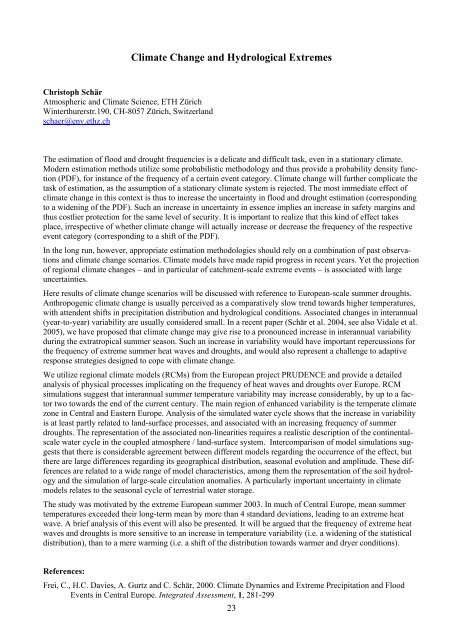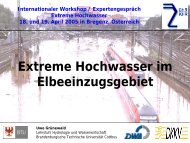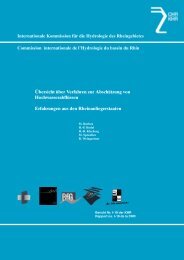ABSTRACTS 'Extreme Discharges' - CHR-KHR
ABSTRACTS 'Extreme Discharges' - CHR-KHR
ABSTRACTS 'Extreme Discharges' - CHR-KHR
You also want an ePaper? Increase the reach of your titles
YUMPU automatically turns print PDFs into web optimized ePapers that Google loves.
Climate Change and Hydrological Extremes<br />
Christoph Schär<br />
Atmospheric and Climate Science, ETH Zürich<br />
Winterthurerstr.190, CH-8057 Zürich, Switzerland<br />
schaer@env.ethz.ch<br />
The estimation of flood and drought frequencies is a delicate and difficult task, even in a stationary climate.<br />
Modern estimation methods utilize some probabilistic methodology and thus provide a probability density function<br />
(PDF), for instance of the frequency of a certain event category. Climate change will further complicate the<br />
task of estimation, as the assumption of a stationary climate system is rejected. The most immediate effect of<br />
climate change in this context is thus to increase the uncertainty in flood and drought estimation (corresponding<br />
to a widening of the PDF). Such an increase in uncertainty in essence implies an increase in safety margins and<br />
thus costlier protection for the same level of security. It is important to realize that this kind of effect takes<br />
place, irrespective of whether climate change will actually increase or decrease the frequency of the respective<br />
event category (corresponding to a shift of the PDF).<br />
In the long run, however, appropriate estimation methodologies should rely on a combination of past observations<br />
and climate change scenarios. Climate models have made rapid progress in recent years. Yet the projection<br />
of regional climate changes – and in particular of catchment-scale extreme events – is associated with large<br />
uncertainties.<br />
Here results of climate change scenarios will be discussed with reference to European-scale summer droughts.<br />
Anthropogenic climate change is usually perceived as a comparatively slow trend towards higher temperatures,<br />
with attendent shifts in precipitation distribution and hydrological conditions. Associated changes in interannual<br />
(year-to-year) variability are usually considered small. In a recent paper (Schär et al. 2004, see also Vidale et al.<br />
2005), we have proposed that climate change may give rise to a pronounced increase in interannual variability<br />
during the extratropical summer season. Such an increase in variability would have important repercussions for<br />
the frequency of extreme summer heat waves and droughts, and would also represent a challenge to adaptive<br />
response strategies designed to cope with climate change.<br />
We utilize regional climate models (RCMs) from the European project PRUDENCE and provide a detailed<br />
analysis of physical processes implicating on the frequency of heat waves and droughts over Europe. RCM<br />
simulations suggest that interannual summer temperature variability may increase considerably, by up to a factor<br />
two towards the end of the current century. The main region of enhanced variability is the temperate climate<br />
zone in Central and Eastern Europe. Analysis of the simulated water cycle shows that the increase in variability<br />
is at least partly related to land-surface processes, and associated with an increasing frequency of summer<br />
droughts. The representation of the associated non-linearities requires a realistic description of the continentalscale<br />
water cycle in the coupled atmosphere / land-surface system. Intercomparison of model simulations suggests<br />
that there is considerable agreement between different models regarding the occurrence of the effect, but<br />
there are large differences regarding its geographical distribution, seasonal evolution and amplitude. These differences<br />
are related to a wide range of model characteristics, among them the representation of the soil hydrology<br />
and the simulation of large-scale circulation anomalies. A particularly important uncertainty in climate<br />
models relates to the seasonal cycle of terrestrial water storage.<br />
The study was motivated by the extreme European summer 2003. In much of Central Europe, mean summer<br />
temperatures exceeded their long-term mean by more than 4 standard deviations, leading to an extreme heat<br />
wave. A brief analysis of this event will also be presented. It will be argued that the frequency of extreme heat<br />
waves and droughts is more sensitive to an increase in temperature variability (i.e. a widening of the statistical<br />
distribution), than to a mere warming (i.e. a shift of the distribution towards warmer and dryer conditions).<br />
References:<br />
Frei, C., H.C. Davies, A. Gurtz and C. Schär, 2000. Climate Dynamics and Extreme Precipitation and Flood<br />
Events in Central Europe. Integrated Assessment, 1, 281-299<br />
23





